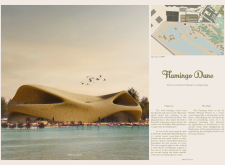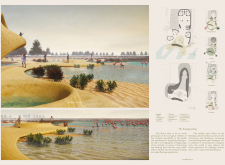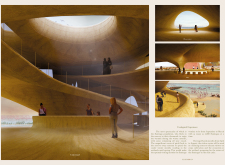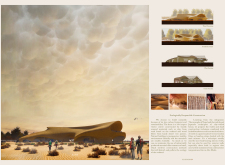5 key facts about this project
This project encapsulates an approach to architecture that emphasizes ecological sensitivity and sustainability. It functions as an interactive space for educational programs, wildlife observation, and community engagement. The design encourages visitors to immerse themselves in the environment, providing areas for observation and interaction without disrupting the delicate ecosystem.
Organic Form and Materials
One of the defining characteristics of the Flamingo Dune project is its organic architectural form that mimics the undulating shapes of sand dunes in the region. This design choice not only minimizes visual disruption but also enhances the building's integration into its natural surroundings. The materiality of the project is equally noteworthy, utilizing locally sourced materials such as sand, clay, straw fibers, and bamboo. These sustainable materials not only reduce environmental impact through lower transportation emissions, but also resonate with the natural context of the wetlands.
The spatial configuration features open courtyards and observation decks that promote airflow and natural lighting, creating an inviting atmosphere for visitors. These design elements encourage exploration and interaction with the surroundings, fostering a deeper appreciation for the ecology of the wetlands.
Adaptive Ecosystem Engagement
Flamingo Dune sets itself apart by emphasizing the importance of adaptive engagement with its ecosystem. The architectural design aligns with ecological practices, such as providing a habitat for local flora and fauna, while also supporting the flamingo population through the introduction of beta carotene crops for dietary enhancement. This level of interaction illustrates an architectural commitment not only to passive observation but also to active participation in ecological stewardship.
To fully understand the depth of the architectural design and functionality of the Flamingo Dune project, readers are encouraged to explore detailed architectural plans, sections, and other architectural designs that capture the nuances of this innovative project. By reviewing these elements, insights into the unique architectural ideas that inform Flamingo Dune will become apparent, enhancing the understanding of its role within the Al Wathba Wetland Reserve.


























